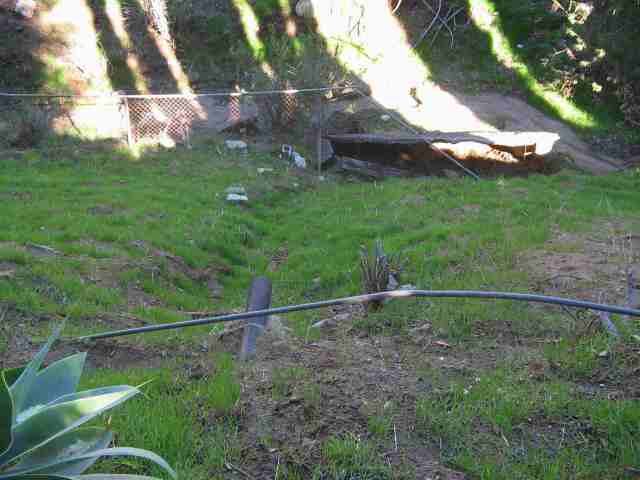Question LookingDown
LookingDown
QUESTION: Hi. I have attempted to attached two photos which depict a drainage problem we have on the hill behind our house. This page seems to permit only one attachment - I'd like to send the second as a follow-up, if you would permit me. Our house is at the top of the hill. We have been told that if the problem is not fixed, we will eventually be endangering the ground under our property. LookingDown.jpg shows the view from our back yard, looking down the hill towards a road. You can see the black drain pipe in front. The water draining from it is causing the erosion. LookingUp.jpg (will send as attchment in follow-up) shows the same area, looking up from the road below us. The ground has only weeds growing which we cut down every May-June for fire prevention. We are near Burbank, CA.
Both photos show the erosion caused by the short black drain pipe. We want to fill the erosion and extend the pipe down as far as possible.
As a short-term solution to the immediate erosion problem, can we use sand bags to fill the gap? Or do we need to put dirt instead? Or both? Sandbags has been suggested by one person but I'd like to see if an expert would agree.
To lengthen the pipe, do we need to fit pipe segments together using some kind of glue, or just fit them together without glue? And how would we anchor it down near the bottom of the hill?
LookingDown.jpg shows a large jagged concrete piece along the fence where a stream can form (running right to left) during heavy rains. It has done this. To divert the stream, we have been told to use big rocks (which we have) to fill in under that large concrete piece. I am mentioning this just to give you info about the bottom in case it's important for you to know. Also, we would like (in future) to start putting down some plants and terracing, but these steps will have to come later. For now, we just want to solve the erosion problem. Thanks for any suggestions. We know it's holiday time, so you may take your time with your reply.
ANSWER: Hi David, I would shorten the drain pipe back to where it is completely underground, then attach flexible drain pipe (available at Home Depot) and lay it in the current ditch all the way to your property line. Use a clamp to attach the flexible pipe to your existing drain. Cover it with 3-4" of soil and then use a tamper (preferably a gas driven one) to firm the soil. Add another 3-4" of soil and pack it again. Repeat the process to near ground level and then lay sod over the area and pin it down with landscape staples.
Another option would be to cover the ditch with landscape fabric and then use large rock to build a dry creek. I prefer the first option.
Jim
---------- FOLLOW-UP ----------
QUESTION: Hi Jim, thanks. With your option #1, let's say we don't plan to put down sod for a while. Does it make a difference whether we use soil or dirt to cover the pipe? Also, it's not a very large area. Can we tamp it down with a hand tool or by hand? Or do we have to use a gas-driven tamper?
ANSWER: The soil needs to have some clay in it to be able to pack it down. Bagged top soil will wash with your first rain. A hand soil tamper will work fine, it's just more work. With a hand tamper, I'd lay 2" of soil at a time and tamp it down, then lay another 2" and so on.
You need to get some grass or groundcover on the hill as soon as possible. Sod is immediate. Seeding may take several weeks or months to get established. If you're in the rainy season, you may want to cover it with landscape fabric to help prevent wash until you plant. Jim
---------- FOLLOW-UP ----------
QUESTION: Thanks - just one more follow-up. I have always thought that grass or groundcover require an irrigation system. Doesn't the same apply to sod?
AnswerYou don't need an irrigation system, but you will need to apply water to get anything started. A hose and sprinkler should suffice.
How often you water once established, will depend on what you plant. Many grasses can go two weeks or more without water. Some groundcovers, like sedums, can go a month or more. With a slope like yours, I prefer manual watering over irrigation systems. You can control the application rate to minimize runoff with a soaker hose or mist sprinkler. Jim






